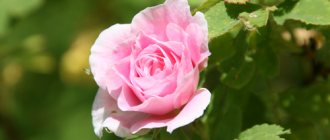History of selection
The history of breeding the Aloha variety goes back decades. The first version of the hybrid was released in 1949. Its appearance occurred thanks to American gardeners. In Europe, roses from the USA are not popular - a local analogue was bred in Germany.
The preparation of the plant and the development of hybrids of the new Aloha were carried out by a popular company specializing in the selection and production of roses - Wilhelm Cordes and Sons. The result was ready by 2003 - Aloha was registered as a new variety. In the official list the variety has several names:
- Aloha;
- Kordes Rose Aloha;
- Aloha Hawaii;
- Korwesrug.
Both varieties, bred in 1949 and 2003, belong to climbers - roses with large inflorescences, tough shoots and repeated flowering throughout the warm season. The main difference between the two hybrids is the color and shape of the bud. The old version of Aloha has delicate pink petals and a cupped or rounded outline.
Excelsa
For varieties of large-flowered roses, I recommend Excelsa, as for small-flowered ones, the buds bloom profusely. The rose blooms throughout the season. Typically, the smaller the flower, the more abundantly and for longer it blooms; there is a compensation either for the size of the flower or for the length of the season.
All small-flowered roses are taken precisely by the quantity and mass of their blooms, which cannot but rejoice.
If we talk about dimensions, then there is an advantage for roses of the repeated type of flowering than in the first 3 years. It's Rose she's feeling enough
https://pin.it/hp2jtce2zhbble
https://pin.it/hp2jtce2zhbble
Description and characteristics of the climbing rose variety Aloha
Aloha 2003 differs from its predecessor primarily in appearance. Large bright buds of a classic shape reminiscent of Bourbon bloom from orange-yellow inflorescences. The average size of a rose is 8-10 cm. The color of the grown flowers is variegated, two-tone: contains an apricot tint.
The Aloha plant as a whole is a rose bush with a height of 2.5 to 3 m. The width reaches 2 m. The foliage is smooth, dense and dense, and has a bright green color. The shoots are distinguished by their rigidity and many thorns. The aroma of the flowers is pleasant, rich, and contains fruity notes. The plant is ready to be cut for a long time and can please the eye of the owner of the house.
The variety develops continuously throughout the summer season: on average, from May to September. Due to the gradual and alternate opening of the buds, flowering periods are difficult to distinguish. This characteristic makes Aloha a frequent guest in landscape design projects. Roses throughout the warm period delight the eye of the owner of the site without losing their color.
Roses are propagated by cuttings. All qualities inherent in the Aloha variety will be preserved under the condition of vegetative transplantation of the plant. Usually, strong, stable bushes become donors after the first wave of flowering.
It will be more convenient to care for roses with specialized gloves to protect your hands from thorns
Planting pit
Rosa homage Barbara
The size of the planting hole for a rose should be determined based on the size of the root system of that plant. The roots should be located freely in the hole; under no circumstances should they be bent or rolled up. Before planting a polyanthus rose, the photo and description of which are presented in this article, mature humus, sand, a complex of microelements, as well as a glass of wood ash must be added to the planting hole.
Humus must be checked for the absence of fungal spores. If there is a white coating on certain parts of the soil, then such humus must be thoroughly dried in the sun before use and only then used as fertilizer for growing roses.
All complex fertilizers, in particular nitrogen ones, must be applied strictly according to the instructions that come with them. Excess nitrogen can only harm the plant. It is best to select fertilizers that are marked “for roses.”
Sand is added only to clayey and heavy soils. Its quantity will be determined depending on the density of the soil. Sandy soils, of course, do not require the addition of sand.
If during replanting the bush was dug up carelessly and the root system was severely damaged, then it is necessary to cut off the flower stems. The main rule is that the size of the above-ground part of the plant should be equal to the underground part. After planting, it is necessary to monitor the soil moisture
Under no circumstances should you allow waterlogging or drying out. If there is a threat of night frosts, then the crop must be covered
After planting, it is necessary to monitor the soil moisture. Under no circumstances should you allow waterlogging or drying out. If there is a threat of night frosts, then the crop must be covered.
Advantages and disadvantages of the variety
The Aloha rose variety has many characteristics that should be taken into account when planting in your garden. First of all, it is important to note the advantages of the variety:
- The long, smooth and abundant flowering period allows Aloha to be called a truly ornamental plant. Its colorful buds can delight the owner with their beauty and scent all summer long.
- Roses are unpretentious and highly resistant to diseases and pests. Aloha is not afraid of black spot and insects, but if not properly cared for it can be susceptible to illness.
- Winter hardiness. Aloha survives cold temperatures down to -8 degrees in a well-designed shelter.
But Aloha also has disadvantages regarding both its main function - decorativeness and plant care.
- Quite large and heavy flowers often sag under their own weight, losing their climbing ability. In order for the variety to serve as a good decoration, it is important to carefully support and strengthen the plant.
- The need to care for the soil. The rose is unpretentious and disease-resistant, but due to its steadfastness it requires careful care of the soil. Thanks to fertilizing the soil once every 2-3 weeks, Aloha is able to grow properly and not cause trouble for the gardener.
- Due to the large number of thorns, roses are inconvenient to replant, prune, or wrap for the winter.
Even the need for fertilizer should not frighten off an experienced and inquisitive gardener who wants to decorate his plot. The Aloha rose is truly worth the effort it takes to grow it and is relatively low hassle.
Features of reproduction
The varietal plant has long vines, so it is easy to propagate using layering. In addition, bushes can be propagated by cuttings, grafting, or dividing the bush.
Seed propagation is not used, since the original maternal traits of the variety may disappear.
The best time for the procedure is late spring or early summer. By autumn, the cuttings have time to take root and easily survive the cold winter. You need to divide the bush into parts in early spring before the growing season begins or in the fall after the leaves fall.
By layering
Climbing roses are most often propagated using layering. The procedure is performed as follows:
- Dig shallow grooves.
- The whips are placed in them and pinned.
- Water it with water and cover it with earth.
Every time the soil begins to dry out, it is moistened. When young plants appear on the vines, they are separated and transplanted to a permanent place.
The Aloha rose does not require much care and can be grown by even a novice gardener. Climbing bushes serve as a decoration for a site for a long time, as the red-orange inflorescences delight others with their spectacular appearance from spring to late autumn.
Growing and care
The main requirement for abundant and healthy flowering of the Aloha variety is fertile soil. To achieve the maximum effect from an ornamental plant, it is important to comply with all the conditions for planting a bush. It is worth giving the characteristics of the optimal environment for growing roses.
- A thoroughly sunny area. The best position for Aloha will be the northeast side of the garden away from tall objects. Roses love light, but in the evening they prefer shading. A good way to provide the plant with protection from the sun is through the canopy of trees.
- No drafts or strong winds. Roses prefer to grow in calm areas, and sudden gusts of air can cause Aloha to grow poorly.
- Full supply of nutrients. Aloha is a large bush, so the necessary minerals reach the appendages with difficulty. Fertilizer is an integral part of variety care.
If a suitable plot of land does not have nutritious soil, then it is worth resorting to a complete replacement of the soil. All unsuitable soil must be removed from the 50x50x50cm hole. This planting area is filled with fertile imported black soil.
Aloha tolerates even harsh Siberian winters: the snow cover acts as an additional protection for the delicate rose
If it is not possible to bring soil, the land is prepared for planting by adding some ingredients. The following will help improve the condition of the soil:
- Clay;
- Humus;
- Superphosphate;
- Potassium salt.
It is the preparation of the soil for Aloha to live in it that will allow you not to resort to fertilizer over the next 2-3 years. The period from planting to complete germination is the most important for the future condition of the rose. As the bushes grow, the need for additional fertilizer and care becomes less.
The planting hole must be at least 30x30x30 cm in size. Planting occurs from April to May, or in the fall - in September and October. In the first year of Aloha’s life, it is necessary to ensure complete rooting of the bushes. To do this, the initially appearing rose buds are removed, which helps improve the nutrition of the root system.
Watering the bushes is carried out abundantly, but rarely. Young seedlings require water once every 10 days, adults are content with moisturizing once every 15-20 days. In extreme heat, the intervals between waterings are reduced. The amount of liquid varies depending on the size of the plant. For large roses - 3-4 buckets, for small ones - up to 10 liters.
In addition, the Aloha rose requires regular loosening of the soil, getting rid of weeds, pruning shoots and preventing possible diseases. Removal of buds that appear in the spring is carried out depending on the purpose of forming the bush.
- Heavy pruning is necessary to rejuvenate wilted bushes.
- The middle one is produced to ensure abundant and early flowering.
- Light pruning is used in the summer to remove old inflorescences.
In order for Aloha to survive the winter, it is not necessary to cover it - frost resistance reaches -8 degrees without additional protection. It is worth taking care of the safety of flowers only during severe frosts. When cold weather sets in, it is important to trim the bushes and hill up the plant. A frame is built around the rose, which is covered with material to calmly await the warm period. With the arrival of spring, Aloha is gradually ventilated - the side walls of the protective structure open.
Feeding roses depends on the time of year: in spring Aloha needs nitrogen, in summer – phosphorus and potassium
Recommendations for planting
Bushes are able to grow in one place for a long time, so the site for them is selected and carefully prepared immediately.
Aloha bushes are planted at the age of 1-2 years: the younger the plants, the easier they adapt to new growing conditions. Purchase seedlings from a nursery or garden center. Before planting, the stems are shortened and the foliage is removed.
Optimal timing
Plantings can be planted in open ground in spring or autumn. The advantage of spring planting is that the roses have time to take root well and adapt to the conditions. Performing the procedure in the autumn allows you to see the color of the buds on the purchased plant.
Plot
A place for planting Aloha roses is chosen that is well lit, but shaded at midday. If the buds are exposed to hot rays of the sun, the petals will begin to lose their rich color, becoming discolored.
Bushes will grow well in partial shade, for example, near some buildings. The main condition is that rainwater from the roofs does not drain onto the plants, otherwise they may become infected with fungal diseases.
The place where roses grow should not be blown by cold winds.
Preparatory work
The area is cleared of debris and dug up. The soil for the bushes is selected to be fertile: if it lacks nutrients, humus is added. If the soil is heavy and clayey, sand is added to it. It is advisable to dig a hole 2 weeks before planting the rose.
The seedling is placed in a bucket of water, and several crystals of potassium permanganate are added to disinfect the plant. Roots that are too long are trimmed, shoots are shortened to 15-20 centimeters.
How to plant: step by step diagram
A hole is dug at least 40 cm deep. Bushes are planted as follows:
- Expanded clay or small stones are placed at the bottom of the hole.
- Then they lay out a 10-centimeter layer consisting of soil mixed with mineral fertilizers.
- A layer of fertile soil is poured on top.
- A seedling is placed in the middle of the hole and covered with soil up to the root collar.
The root circle is lightly compacted, watered abundantly, and mulched.
Pests and diseases
Some gardeners note that the Aloha rose is susceptible to attack:
- Spider mites;
- Black spot;
- Rust;
- Powdery mildew;
- Aphids;
- Sawflies;
- Leaf roller.
This can only happen if all necessary preventive and care measures are not followed. Otherwise, the rose is unpretentious and does not react to illnesses. Aloha has a strong immune system and prefers not to be capricious if its gardener responsibly complies with all requirements and carefully fertilizes the plant.
Application in landscape design
Aloha can decorate an area by itself without additional processing: its bright green foliage with unusually colored flowers looks good in its pure form. Large delicate buds with a pleasant fruity smell will be an excellent decoration for any area. The rose harmonizes perfectly with arches and columns. The structures are entwined with shoots and acquire natural beauty. Thanks to the climbing nature of the shoots, the rose effectively grows over any frame, becoming a hedge or small decoration. Vertical gardening also helps hide defects on the walls of buildings.











